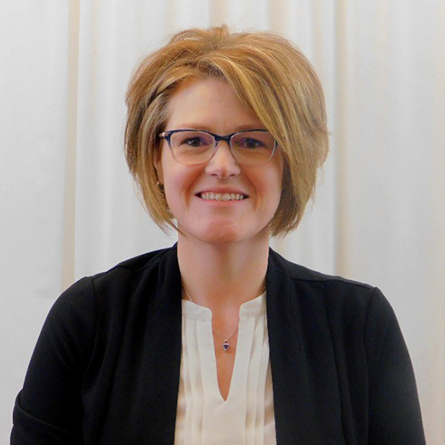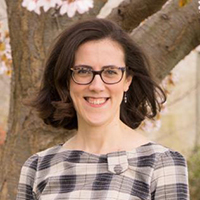
Laptops to fight inequality
The Student Technology Resource Fund provides computers and other technology for students with financial need.
The laptop Lauren Sullivan ’19 brought to Conn wouldn’t turn on unless it was plugged in. If it was accidentally unplugged, the four-year-old PC, issued to Sullivan by her high school, would crash.
“I stopped carrying it to class, because it ended up being a useless weight in my bag,” Sullivan remembered. “The worst part was, I was taking a computer science class at the time. Because of the software we were using, the only place I could do my assignments was the computer lab where we had class.”
Then Sullivan learned about the Student Technology Resource Fund, which provides computers and other technology for students with financial need. She applied and was issued a new Mac laptop at the beginning of her sophomore year.
“I felt so relieved,” said Sullivan, a biochemistry major with a computer science minor. “It was one less thing I had to worry about, and I was able to focus all my effort on my strenuous course load.”
The fund, established in 2006, was the brainchild of the late Erika Berlinghof ’05. A fiercely independent two-time cancer survivor, Berlinghof, her father William Berlinghof remembered, traveled to Conn by herself and decided to attend without ever consulting her parents. On campus, she was active in student government and quickly recognized a growing technological divide between students.
“She talked about how there were students who couldn’t fully participate in all the things available at Conn because they didn’t have a computer to connect them in the way that everyone else took for granted,” said Mr. Berlinghof.
At the time, personal computer use was exploding, and professors were beginning to assign more online research, host online discussions and communicate via email. But for Erika the problem went deeper than just the logistical issue of completing classwork without a computer; it created a “have vs. have-not” culture on campus that was inherently inequitable.
“It branded them as different. She wanted to level the playing field,” Mr. Berlinghof said.
At Erika’s suggestion, the Berlinghof family established the fund after her graduation, and she moved to Washington, D.C., where she directed lobbying for the National Association of Water Companies. Most recently, she was the director of communications and engagement for the U.S. division of SUEZ Environment, an international water and wastewater services company. She was also active with Water For People, a nonprofit that works to provide access to potable water for people in developing countries, and campaigned for Hillary Clinton both times she ran for president.
In 2015, after being in remission for 15 years, Erika was diagnosed with a sarcoma in her heart for a third time, and she died on May 1, 2016. Her family continues to contribute to the Student Technology Resource Fund as a way of honoring Erika’s belief in the importance of reducing societal inequalities.
It’s an impressive legacy, said Ricardo Olea ’19, who received a new laptop thanks to the fund.
“This fund is continuously combating social inequities that make it difficult for students from backgrounds like mine to not only make it to a higher education institution but also complete a degree,” he said. “Owning a computer as a college student is extremely essential; it allows us to stay connected not only with professors and peers but on a national and global level as well.”
The fund routinely provides computers for more than a dozen students each year, and the need continues to grow. Students receiving financial aid are eligible for the program if they do not have a computer or in the event that their computer fails. Associate Dean of the College Marina Melendez, who administers the program, oversees a committee that reviews each request and assesses the student’s need.
“It is difficult to imagine a world without computers, yet this is a reality for some college students,” Melendez said. “Too many still come to campus without one, which puts them at a great disadvantage.”
Giselle Olaguez ’19 is one of those students. The economics and gender and women’s studies double major is proud of her accomplishments at Conn. She’s a scholar in Conn’s Toor Cummings Center for International Studies and the Liberal Arts; she’s an active member of Movimiento Estudiantil Chicano de Aztlán; and she’s volunteered at the Immigration Advocacy and Support Center in New London, as well as at a local elementary school. This summer, she will conduct research on women’s rights movements in Mexico.
"I have taken advantage of the Conn education I have been blessed with. But behind my success is a story others often don't know," Olaguez said.
The oldest of five children from a working-class family, Olaguez came to campus without a computer. In addition to her schoolwork, clubs and volunteer activities, she worked four jobs—three positions on campus and the overnight shift at a local McDonald’s. That schedule often made it difficult for her to get to the library or a computer lab.
“I remember the day I received a call that I could pick up my new computer. I was so excited—even the box was pretty,” she said. “I was finally able to do my homework at any time of day; between my shifts I could plop down anywhere and write a post for one class or do a reading for another.”
Mr. Berlinghof said Erika wanted students like Olaguez to have everything they needed to succeed not just during college but after graduation as well.
“She felt strongly that women and minorities were underrepresented in government and that more diversity would change the attitudes that lead to social and economic inequality,” he said.
The Student Technology Resource Fund is one piece of the puzzle. There are other funds designed to meet certain needs, including a Student Emergency Fund, which provides support for emergency travel and other expenses, and the Into the Future Fund, which helps seniors and new graduates offset costs for job and graduate school interviews.
Mr. Berlinghof, who has also supported scholarships at Conn, hopes to see the Student Technology Resource Fund grow to meet the needs of more students and to provide them with the emerging technologies that are quickly becoming as important to education as a computer.
“What is the cutting-edge software the students need? Do they need other devices? As technology changes, we want all students to have what they need to be able to fully participate,” he said.
To donate to the Student Technology Resource Fund, go to giving.conncoll.edu and note “Student Technology Resource Fund” in the comment box. For more information, contact Valerie O’Brien, director of donor relations, at vobrien@conncoll.edu.

